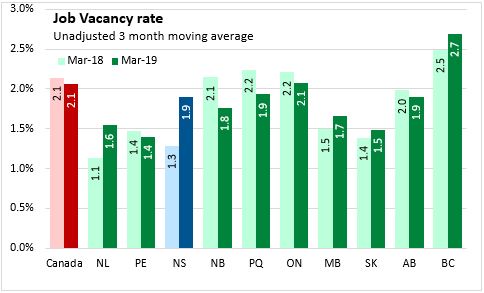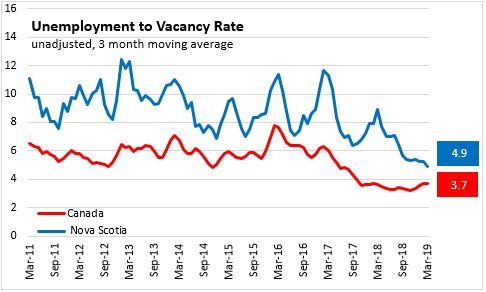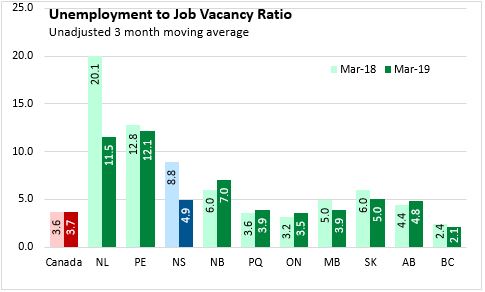The Economics and Statistics Division maintains archives of previous publications for accountability purposes, but makes no updates to keep these documents current with the latest data revisions from Statistics Canada. As a result, information in older documents may not be accurate. Please exercise caution when referring to older documents. For the latest information and historical data, please contact the individual listed to the right.
<--- Return to Archive
For additional information relating to this article, please contact:
June 27, 2019JOB VACANCIES, MARCH 2019 In the 3 months ending in March 2019, there were an average of 7,300 job vacancies in Nova Scotia (unadjusted for seasonality). This is 2,500 more than reported in the same period of 2018.

Nova Scotia's job vacancy rate, the share of labour demand that is unfilled, rose to 1.9 per cent in March. This is 0.6 percentage points higher than observed for the same period in 2018. Job vacancy rates were lower in the early months of 2018, but rose through the second half of the year. Nova Scotia's March job vacancy rate is the highest level in records dating back to 2011, despite falling in the usually slack winter months. Nova Scotia's unemployment rate reached a seasonally adjusted low of 6.2 per cent in March 2019 (lowest since the start of the monthly labour force survey in 1976).
The national job vacancy rate was 2.1 per cent, about the same as it was at this time last year.

Across Canada, job vacancy rates are highest in British Columbia (2.7 per cent), followed by Ontario. The lowest job vacancy rates were in Prince Edward Island and Saskatchewan. Compared with the same period last year, the job vacancy rate has increased in five provinces with the largest increases in Nova Scotia and Newfoundland and Labrador.

There were an average of 4.9 unemployed persons per job vacancy in Nova Scotia in the 3 months ending in March 2019, down from 8.8 in the three months leading up to March 2018. The ratio of unemployed persons per vacancy has fallen substantially over the last year, with the March result the lowest since monthly job vacancy data started in 2011.
The national ratio of unemployed persons per job vacancy (3.7) was up slightly over the same period in 2018.

Six provinces reported fewer unemployed persons per job vacancy in March 2019 compared with the same period last year. The largest declines were in Newfoundland and Labrador and Nova Scotia.
British Columbia currently reports the tightest labour market conditions in Canada, with a job vacancy rate of 2.7 per cent and just 2.1 unemployed persons for each job vacancy. Prince Edward Island reported the most labour market slack, with 12.1 unemployed persons for each job vacancy and a job vacancy rate of 1.4 per cent. Both Newfoundland and Labrador and Nova Scotia reported substantial tightening of labour markets over the last year.
Nova Scotia and Alberta currently report very similar conditions of labour market tightness - job vacancy rates are 1.9 per cent in each province while there are 4.9 unemployed persons per job vacancy in Nova Scotia vs 4.8 in Alberta.

Source: Statistics Canada. Table 14-10-0224-01 Job vacancies, labour demand and job vacancy rate, three-month moving average, unadjusted for seasonality,
<--- Return to Archive